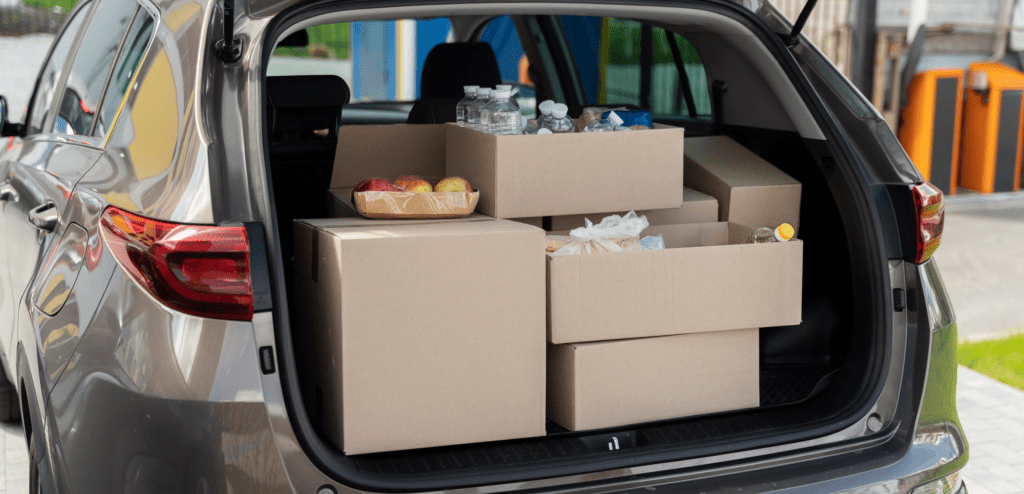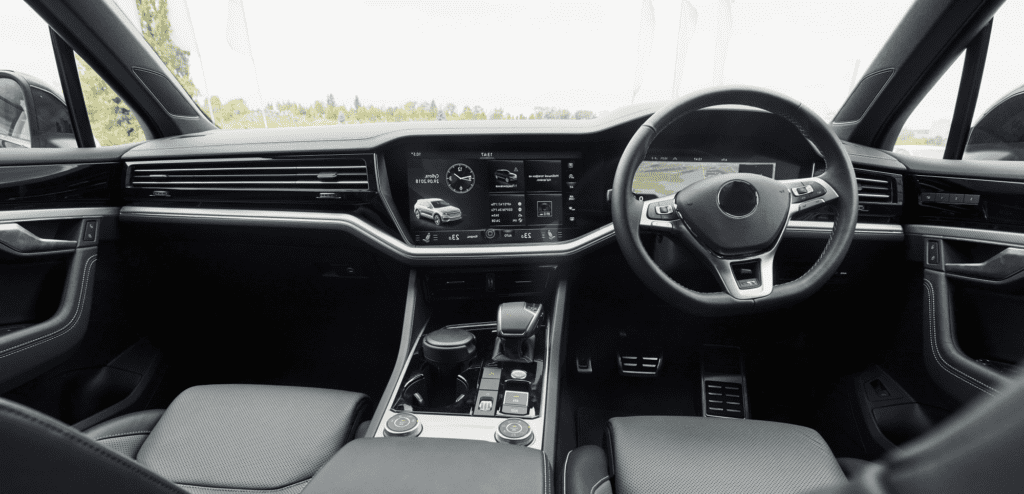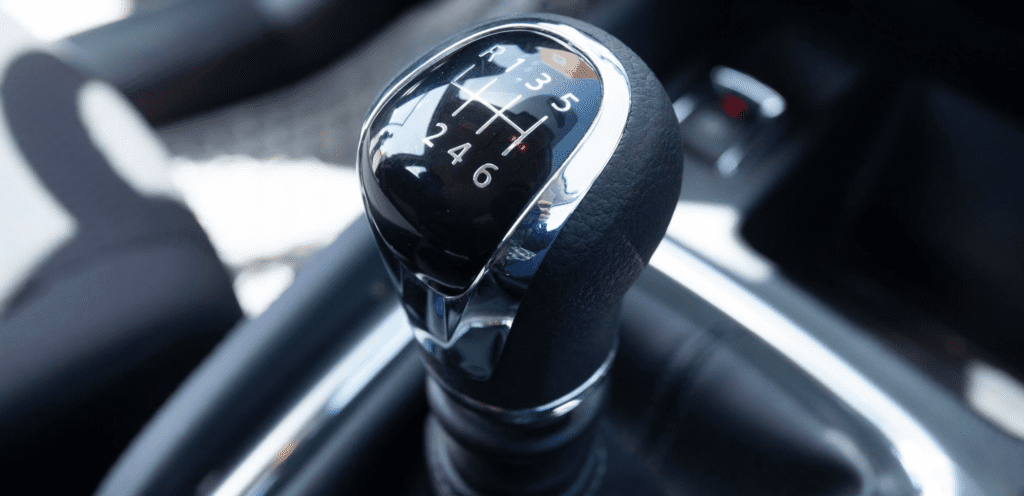
When embarking on the journey of learning to drive, there is an abundance of information to absorb, and inevitably, there will be situations on the road that you may not have anticipated. Some aspects of driving only become apparent once you have received your full driver’s licence.
- Different types of load
- What extra weight does to your car
- How gears work
- Adjusting your driving
- Tips to prevent wear and tear when driving with a heavy load
One aspect that often catches new drivers off guard is the impact of different loads on the car. It becomes evident that driving with additional weight in the vehicle can significantly alter the driving experience. This realisation dawns upon many newly licenced drivers, as they find themselves behind the wheel with more than just their driving instructor on board.
It’s important to understand that extra weight can affect your car’s performance, and thus, requires certain adjustments in driving technique. If your vehicle feels like it is struggling under the burden of the load, it doesn’t necessarily indicate a deficiency in its capabilities.
However, there are measures you can take to ensure that your cherished automobile remains in good condition and to optimise its efficiency.
One crucial aspect to consider is the appropriate gear selection when the added weight affects the car’s handling. Familiarising yourself with the gearstick and selecting the appropriate gear can prevent unnecessary strain on the engine, minimise emissions, and enhance fuel economy.
Now, let’s delve deeper into the specifics of how different loads can influence your driving experience and the necessary steps to ensure a smooth and efficient journey.
Different types of load
Owning a car brings about a great deal of convenience as it enables you to transport not only yourself but also various objects and passengers from one place to another. Throughout your car ownership journey, it is highly likely that you will find yourself loading it with a diverse range of items.
In order to maintain safety and prevent potential damage, there are two important rules to remember:
- Never overload your vehicle
- Distribute any additional weight you carry across the car
By adhering to these guidelines, you can ensure stability and protect your vehicle in the long run. However, the specific approach to following these rules depends on the type of loads you are transporting.
Now, let’s take a moment to explore the most common categories of weight that your car may have to accommodate. By familiarising ourselves with these different load types, we can better understand their implications for safe and efficient transportation.
Passengers
When you’re driving, the most obvious additional weight you’ll have to carry is passengers. Whether they’re furry or human friends, your car can only carry so many living things.
An average car provides five seats for people and a boot that could probably safely accommodate a pet or two. Even when you stick to these numbers, it can make a big difference to the driving experience.

For one thing, passengers add weight to your car, which can affect its handling and performance. This is especially true if you’re carrying a lot of people in the back seat. The extra weight can make your car feel sluggish and less responsive and make it harder to brake and turn.
In addition to the added weight, passengers can also be a distraction. They might talk to you, argue with each other, or even try to take over the driving. This can be incredibly dangerous, as it can take your attention away from the road.
If you’re going to be driving with passengers, it’s important to set some ground rules. First, make sure everyone is wearing a seatbelt. Second, ask them to keep their voices down and not distract you while driving. If they’re arguing or being disruptive, pull over to a safe spot and let them know that their behaviour is unacceptable.
If you’re a new driver, it’s especially important to be careful when driving with passengers. Start by taking short trips with just one or two people. As you get more comfortable, you can gradually increase the number of passengers you’re comfortable with.
And remember, if any of your passengers start giving you unsolicited driving advice, you can always tell them to get out and walk.
Here are some additional tips for driving with passengers:
- Make sure all passengers are aware of the car’s emergency procedures.
- If you’re carrying children, ensure they have appropriate car or booster seats.
- If you’re carrying pets, make sure they’re properly restrained.
- Be aware of the weight of your passengers and adjust your driving accordingly.
- Don’t let passengers distract you while you’re driving.
- If you’re feeling overwhelmed, pull over to a safe spot and take a break.
With a little planning and common sense, you can safely and comfortably drive with passengers.
Baggage
Baggage refers to the belongings that are carried and stored in your car while travelling. It’s not about the emotional baggage that is associated with pent-up emotions. Instead, we’re talking about the physical bags and suitcases that contain your travel essentials.
You may have fond memories of your childhood holidays when your parents meticulously packed various pieces of luggage into every available space in the car before embarking on a journey.

The reason behind this careful packing wasn’t just to play a complex version of Tetris (although we can’t rule out the possibility); it was primarily done to evenly distribute the weight throughout the vehicle.
Since a car is supported by four wheels, having a majority of the load concentrated in one corner can disrupt the balance and equilibrium of the vehicle’s mechanics.
This imbalance can have adverse effects on crucial aspects such as steering and braking, which are vital for maintaining control and ensuring your safety while driving.
In addition to distributing the weight evenly, it’s important to ensure that the luggage stored in your car does not obstruct your view or protrude in a hazardous manner.
Clear visibility is crucial for safe driving, and any obstructions can significantly impede your ability to see the road and react to potential hazards effectively.
Therefore, when loading your car with baggage, it’s essential to consider both the weight distribution and the obstruction of your view. By doing so, you can help maintain the proper balance of your vehicle and ensure a safe and enjoyable journey.
Roof racks
When it comes to transporting cargo, some individuals prefer to free up space inside their vehicles, and this is where roof racks prove to be incredibly useful. These convenient devices allow you to carry items on the roof of your car. However, it’s important to note that roof racks are considered a load, whether they are empty or being used to transport items.

To ensure the safety and effectiveness of using roof racks, it is highly recommended to seek professional advice on how to properly attach and secure the specific model of the roof rack to your car. Each vehicle may have different attachment mechanisms and weight capacities, so obtaining expert guidance will help you avoid any potential risks or damage.
When loading items onto the roof rack, it’s crucial to secure them tightly and prevent any movement or shifting during the journey. Unsecured loads can become hazardous, not only for you but also for other drivers on the road. Properly fastening the cargo will help maintain stability and prevent any potential accidents or damage.
Before embarking on your journey, take the time to double-check that the roof rack is securely attached and the load is firmly fastened. Regularly inspect the fastenings during longer trips to ensure they remain tight and secure. Additionally, be mindful of the height clearance of your vehicle with the loaded roof rack, especially when entering areas with low overhead clearance such as parking garages or underpasses.
By following these precautions and obtaining professional guidance, you can make the most of roof racks as a practical solution for transporting additional cargo, while also ensuring the safety of yourself and others on the road.
What extra weight does to your car
Stopping and starting
When your car carries additional weight, it can have noticeable effects on its performance, particularly when it comes to stopping and starting.
- Starting: You will likely feel that your vehicle requires more effort to get moving when it is carrying excess weight. This is because the added weight increases the friction between the wheels and the road. As a result, you may need to apply more acceleration than usual to get the car going and maintain a steady speed.
- Stopping: Conversely, the increased weight can also prolong the time it takes for your car to come to a complete stop. Consider this: with the extra weight pushing the vehicle forward, it requires additional braking force to counteract the momentum. Therefore, it’s important to anticipate this extended stopping distance when you have a loaded car.
To ensure a safe driving experience when your car is loaded with extra weight, it is essential to be attentive and adjust your driving behaviour accordingly. Exercise extra sensitivity and control when operating the brake and accelerator pedals.
Pay particular attention when driving uphill, as more acceleration may be required to overcome the added weight, and when driving downhill, as more braking force will be needed to safely control the vehicle’s speed.
By being mindful of these factors and adapting your driving technique, you can effectively manage the impact of extra weight on your car’s performance, ensuring a smoother and safer journey.
Steering
The presence of additional weight in your vehicle can significantly impact its steering dynamics, requiring you to make adjustments to ensure safe and controlled manoeuvres.

Cornering: When navigating corners, it’s important to approach them with caution and take your time to assess how the car responds to steering inputs. The increased weight can cause the vehicle to be less responsive and take longer to initiate a turn.
It’s crucial not to overcompensate by making abrupt or excessive steering adjustments. Instead, maintain a steady and controlled approach to maintain stability and prevent loss of control.
Straightening: Similarly, when straightening the wheels after a turn, be aware that the increased weight may cause a delay in the vehicle’s response. It might take longer for the car to align itself in a straight line. Therefore, exercise patience and give the car enough time to adjust its direction naturally.
Neglecting proper steering techniques can lead to potentially dangerous situations. For instance, if you have a heavy load in the trunk, the rear of the car may swing out wider than expected during turns, posing a risk to other road users.
Being mindful of this and taking appropriate precautions is essential to maintain the safety of yourself and others on the road.
To mitigate these risks, it’s recommended to adjust your driving style accordingly when carrying extra weight. Take corners at a moderate speed, avoid sudden or aggressive manoeuvres, and give yourself ample time to react and adapt to the car’s handling characteristics.
By doing so, you can ensure a smoother and safer driving experience even with the added weight in your vehicle.
Fuel consumption
Driving with a heavy load can have a noticeable impact on fuel consumption due to increased energy requirements and the need for additional acceleration.
- Increased Fuel Usage: Carrying extra weight necessitates more initial acceleration, which leads to higher fuel consumption. The added effort of hauling the additional load puts a greater demand on the car’s energy resources, primarily petrol. Similar to how you might feel the need to eat snacks earlier during a hike when carrying a heavy rucksack, cars also require more fuel as the load gets heavier.
- Efficiency through Proper Gear Usage: One effective way to reduce overall fuel consumption is by ensuring you are driving in the appropriate gear. Operating the vehicle in the correct gear for the given speed and load conditions allows the engine to operate efficiently, optimising fuel consumption. It’s important to avoid over-revving the engine or driving in too high a gear when carrying a heavy load, as this can lead to unnecessary fuel consumption.
Additionally, practicing smooth and steady driving techniques can help improve fuel efficiency. Avoiding sudden accelerations or harsh braking reduces energy wastage and promotes more economical fuel usage.
To minimise the impact on fuel consumption when driving with extra weight, it’s advisable to plan ahead and only carry necessary items. Avoid unnecessary cargo or excessive baggage whenever possible. By doing so, you can help improve fuel efficiency, reduce your carbon footprint, and potentially save on fuel costs.
Remember, fuel consumption can vary depending on various factors such as vehicle type, engine size, and driving conditions. It’s always a good idea to consult your vehicle’s manual or seek professional advice to understand the specific recommendations for fuel-efficient driving with added loads.
How gears work
What brings many of the driving issues mentioned above together? The gears! When you engage a gear, you’re connecting the gearbox to the engine, enabling it to transmit power to the wheels of the car.

Gears regulate the amount of speed and force transmitted by the engine. Lower gears deliver greater force but lower speeds, whereas higher gears allow for higher speeds with less force. That’s why when you’re driving in 5th gear, for instance, you don’t need as much acceleration as when you’re in 1st gear.
Throughout your drive, it’s crucial to determine the kind of power required by the car and select the appropriate gear accordingly. (Of course, if you’re driving an automatic, this will be taken care of for you!)
Gears play a significant role in optimising vehicle performance. Choosing the right gear allows the engine to operate efficiently, striking a balance between power and speed. This not only results in smoother acceleration and deceleration but also contributes to improved fuel efficiency.
Understanding how gears work and their impact on your driving experience can enhance your control over the vehicle, leading to a more enjoyable and efficient journey.
Adjusting your driving
Setting off
When driving with a heavy load, it’s important to strike a balance between safety and fuel efficiency. As you gain more experience as a driver, you’ll develop a sense for when a gear change is needed. If you hear or feel that the car is struggling to maintain momentum, it’s likely time to downshift by one or two gears.
Since driving with a heavy load requires more power to set off, you may find it necessary to stay in a lower gear for a longer duration than usual. This allows the car to generate sufficient force to reach a steady pace and overcome the added weight.
By being attentive to the sound and feel of the engine, you can gauge when a gear change is required. Downshifting when necessary ensures that the engine operates in its optimal power range, providing the necessary “oomph” to propel the vehicle smoothly.
Remember, finding the right gear for setting off with a heavy load is a skill that improves with experience. By staying in tune with your vehicle and making appropriate gear adjustments, you can ensure a safe and efficient start to your journey.
Hills
Carrying a heavy load in your vehicle can affect its starting, stopping, and steering, creating a dragging or pulling sensation. It’s no surprise that these effects become more pronounced when driving on uphill or downhill slopes.
When driving uphill, you may need to compensate for the load’s opposing force pulling the car backwards. Staying in 1st or 2nd gear (depending on the steepness of the hill) ensures you have enough power to keep the car moving forward. Prepare for the fact that you will likely need to apply more acceleration to overcome the uphill resistance.

On the other hand, driving downhill presents a different challenge. The added weight propels the car forward with increased force, potentially causing it to gather speed rapidly, which can be hazardous. Even though the situation has reversed, it is still advisable to use a lower gear.
However, in this case, the lower gear is not primarily for generating force but rather to restrict speed. By staying in a lower gear when descending a hill, you limit the vehicle’s speed. This allows the engine to assist with braking as it restricts how fast the car can go downhill, providing additional control and stability.
When driving on hills, it’s crucial to adapt your gear selection and use appropriate acceleration and braking techniques to maintain safety and control. Adjusting your driving style to the demands of the terrain helps ensure a smooth and secure journey.
Tips to prevent wear and tear when driving with a heavy load

-
Refer to your car’s manual to determine its maximum load capacity and ensure you do not exceed it. Overloading the vehicle can lead to excessive wear and tear on critical components such as the clutch and brake pedals.
-
Before embarking on long journeys with a heavy load, increase the air pressure in your tyres to the recommended level. This helps support the extra weight and maintains proper tyre performance.
-
Check and adjust the aim of your headlights if necessary. When your car is heavily laden, the beam may tilt higher, potentially causing glare and discomfort for other drivers. Properly aligned headlights ensure optimal visibility without dazzling others.
-
Travel light whenever possible. Avoid carrying unnecessary heavy equipment in your car unless it is essential for your journey. The additional weight puts strain on the vehicle and impacts fuel efficiency.
-
Ensure even weight distribution for the load you are carrying. Properly distribute the weight across the vehicle to maintain balance and stability. This helps prevent excessive strain on specific areas and enhances overall handling.
-
Keep in mind that when driving with a heavy load, your car will consume fuel at a faster rate. Plan accordingly and be prepared for more frequent refuelling stops on your journey.
-
Exercise caution and drive with a gentle touch when stopping, starting, or steering. Take things slow and steady, and be extra sensitive with the brake and accelerator pedals to maintain control and minimise stress on the vehicle.
-
When traversing uphill or downhill, select and maintain a lower gear to maximise your control over the vehicle. This helps optimise engine braking and prevents excessive speed build-up, ensuring safer and more manageable descents and ascents.
-
Remember, not making the necessary adjustments and precautions can jeopardise the safety of other road users and potentially cause damage to your vehicle. Treat your car with care and respect, as it serves you faithfully.
By following these tips, you can help preserve your vehicle, enhance safety, and promote a smoother driving experience when carrying a heavy load.


